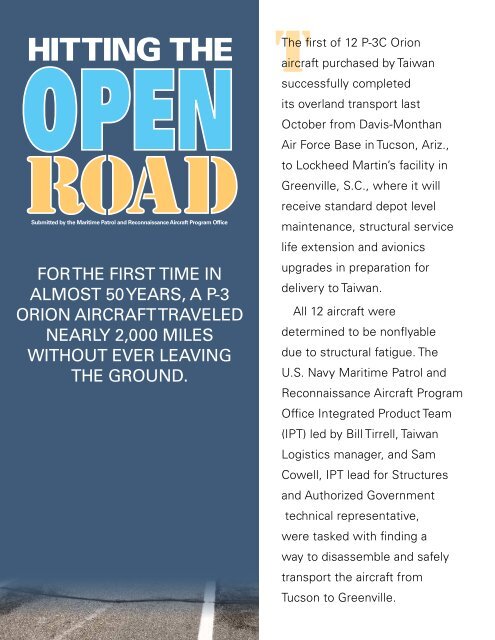Aeronautics - Magazooms
Aeronautics - Magazooms
Aeronautics - Magazooms
Create successful ePaper yourself
Turn your PDF publications into a flip-book with our unique Google optimized e-Paper software.
HITTING THE<br />
Submitted by the Maritime Patrol and Reconnaissance Aircraft Program Office<br />
FOR THE FIRST TIME IN<br />
ALMOST 50 YEARS, A P-3<br />
ORION AIRCRAFT TRAVELED<br />
NEARLY 2,000 MILES<br />
WITHOUT EVER LEAVING<br />
THE GROUND.<br />
TThe first of 12 P-3C Orion<br />
aircraft purchased by Taiwan<br />
successfully completed<br />
its overland transport last<br />
October from Davis-Monthan<br />
Air Force Base in Tucson, Ariz.,<br />
to Lockheed Martin’s facility in<br />
Greenville, S.C., where it will<br />
receive standard depot level<br />
maintenance, structural service<br />
life extension and avionics<br />
upgrades in preparation for<br />
delivery to Taiwan.<br />
All 12 aircraft were<br />
determined to be nonflyable<br />
due to structural fatigue. The<br />
U.S. Navy Maritime Patrol and<br />
Reconnaissance Aircraft Program<br />
Office Integrated Product Team<br />
(IPT) led by Bill Tirrell, Taiwan<br />
Logistics manager, and Sam<br />
Cowell, IPT lead for Structures<br />
and Authorized Government<br />
technical representative,<br />
were tasked with finding a<br />
way to disassemble and safely<br />
transport the aircraft from<br />
Tucson to Greenville.<br />
T“The fuselage was the challenge,” said<br />
Tirrell. “We looked into transport by<br />
rail; however, the fuselage requires<br />
special handling. Transport by rail would<br />
require the fuselage to be transferred on<br />
and off truck beds four times.”<br />
To reduce the risk of damage<br />
during loading, the team opted for<br />
transportation across country by<br />
flatbed truck — a process which<br />
would only require moving the fuselage<br />
twice. A suitable truck was located,<br />
and a transport cradle was designed<br />
specifically for holding the fuselage.<br />
According to Tirrell, the design of<br />
the cradle was crucial in preventing<br />
structural damage while ensuring the<br />
aircraft could sustain the 2,000-mile<br />
overland trip and remain operationally<br />
capable for Taiwan after reassembly.<br />
The team determined that a<br />
refurbished version of the BL-65 tool<br />
was the best option for securing the<br />
fuselage to the transport cradle. The<br />
BL-65 tool was used in the original P-3<br />
"Transport by rail would<br />
require the fuselage to<br />
be transferred on<br />
and off truck beds<br />
four times.”<br />
- BIll Tirrell<br />
production line more than 50 years ago<br />
as a substitute landing gear to move<br />
the aircraft around the production<br />
facility safely.<br />
“We pulled out the old blueprints<br />
and made a few modifications to<br />
withstand the heavy lifting that would<br />
be necessary to move the aircraft,”<br />
Cowell said.<br />
The redesigned BL-65 tool bolted to<br />
the aircraft at the wing joints and gave<br />
the team a sturdy framework that could<br />
be securely fastened to the transport<br />
cradle. Finally the entire assembly —<br />
fuselage, BL-65 tool apparatus and<br />
transport cradle — was chained to<br />
the flatbed truck.<br />
Once the team designed and built all<br />
the specialized components, the aircraft<br />
Official U.S. Navy Photo<br />
The first of 12 P-3C Orion aircraft purchased by Taiwan is secured on an oversize flatbed<br />
tractor trailer in preparation for delivery from Davis-Monthan Air Force Base in Tucson,<br />
Ariz., to the Lockheed Martin facility in Greenville, S.C., where it will undergo repairs and<br />
upgrades before final delivery to Taiwan.<br />
was disassembled and loaded onto nine<br />
trucks. Four oversize flatbed trucks<br />
carried the fuselage, wings, empennage<br />
and horizontal tail section. The<br />
remaining five tractor trailers housed a<br />
large number of crated components. The<br />
engines, propellers and landing gear will<br />
be shipped separately to various depots<br />
for repair and overhaul prior to final<br />
delivery to Greenville.<br />
The careful disassembly and<br />
preparation of the aircraft for<br />
transport was completed by Aerospace<br />
Maintenance and Regeneration Group<br />
(AMARG) at Davis-Monthan AFB<br />
under budget and in less than the<br />
anticipated six months.<br />
“When the aircraft arrived at<br />
Greenville, we performed extensive<br />
symmetry and alignment tests on<br />
the fuselage and found that all of the<br />
transport components performed as<br />
expected,” Cowell said. “The aircraft<br />
experienced no bending and no twisting<br />
during transport. It stayed true to shape.”<br />
The second aircraft is already<br />
undergoing disassembly by AMARG,<br />
and the remaining aircraft will be<br />
transported over the next three years.<br />
The final aircraft is scheduled to leave<br />
Davis-Monthan AFB in June 2013.<br />
“We consider the first complete<br />
nondestructive disassembly and<br />
overland transport highly successful,”<br />
Tirrell said. “All of the special support<br />
equipment performed as designed,<br />
and our procedures for loading and<br />
transporting the P-3C fuselage have<br />
proven successful.”<br />
The successful transport of the first<br />
P-3C aircraft has caught the interest of<br />
other government organizations. The<br />
method has been requested by the U.S.<br />
Forest Service and Homeland Security,<br />
as well as other Foreign Military Sales<br />
P-3 operators. ★<br />
“. . . we performed<br />
extensive symmetry<br />
and alignment tests on<br />
the fuselage and found<br />
that all of the transport<br />
components performed<br />
as expected.”<br />
- Sam Cowell<br />
22 23

















